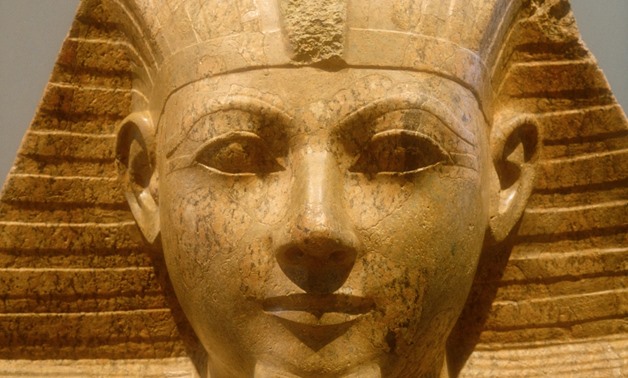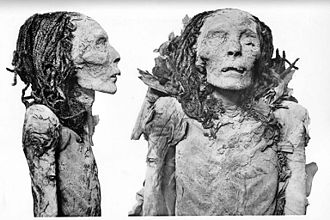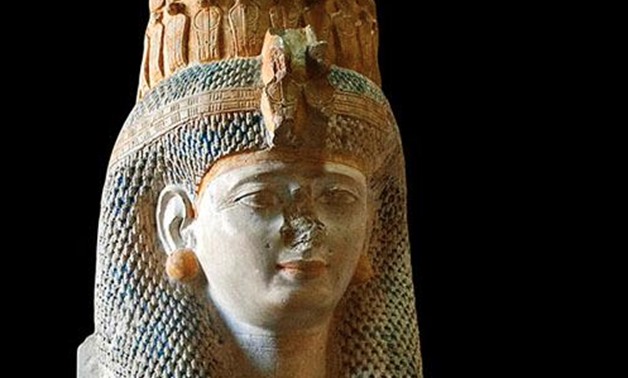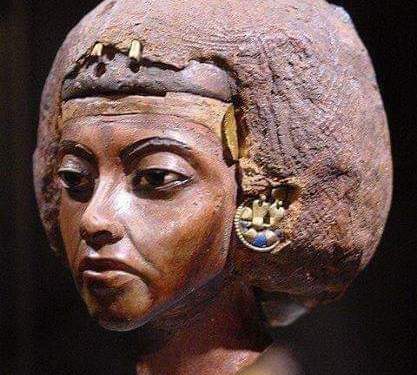CAIRO - 4 April 2020: Among the royals that moved in the historical march of the Pharaohs' Golden Parade in Egypt, on April 3, are four queens that carved their names deep in the country's ancient history.
The Pharaohs' Golden Parade moved 22 ancient Egyptian royal mummies, 18 kings and four queens, through the streets of Cairo to their new resting place at the Museum of Egyptian civilization in Fustat, south of the Egyptian capital.
The four queens received special attention. Many searched their history and were keen to know what qualified them to rule Egypt in such ancient eras.
"They planned, ruled, and ascended to the throne. They amazed everyone with their strength and intelligence." This is how four Pharaonic queens succeeded thousands of years ago in becoming equal to the male kings in their leadership in both religious and worldly lives, becoming an inspiring symbol to this day.
Hatshepsut
Hatshepsut was the fifth Pharaoh of the 18th Dynasty of Egypt, one of the greatest queens, and the most beautiful of women, the powerful queen who shook the world and made everyone bow in reverence and glory in front of her power.

Egyptologist, Hussein Abdel-Basir, said in a special statement to "Sky News Arabia" about Queen Hatshepsut, “She is the daughter of King Thutmose I, one of the most famous figures in history of ancient Egypt.”
She married her half-brother, Thutmose II, so Hatshepsut became regent of the throne of Egypt and the de facto ruler of the country. She ruled for several years on behalf of her husband's son, Thutmose III, who was young when he ascended the throne.
Hatshepsut came to the throne of Egypt in 1478 BC, although traditions in ancient Egypt forbade a woman from becoming a queen. Based on the fact that her bloodline was impeccable as she was the daughter, sister, and wife of a king, Hatshepsut declared herself a queen.
The mummy of Queen Hatshepsut was found in 1903 in the tomb (AD 60) in the Valley of the Kings in Luxor, according to the Egyptian Ministry of Antiquities.
Abdel-Basir explains that the end of Queen Hatshepsut's rule is a mystery, as no one knows how her life ended. But it is now known that her pictures and names were erased from above her tracks by the men of King Thutmose III at the end of his reign, not at the beginning of his reign as was previously thought.
Abdel-Basir notes that her full name is "Ghanemat-Amun Hatshepsut", meaning "united with Amun, the best of women."
Hatshepsut was one of the most prolific builders in Ancient Egypt, commissioning hundreds of construction projects throughout both Upper and Lower Egypt. She built the Temple of Pakhet at Beni Hasan, South of Minya Governorate.
During her reign, so much statuary was produced that almost every notable museum with Ancient Egyptian artifacts in the world has Hatshepsut statuary among their collections; for instance, the Hatshepsut Room in New York City's Metropolitan Museum of Art is dedicated solely to some of these pieces.
Ahmose-Nefertari
Abdel-Basir spoke about Queen Ahmose Nefertari, explaining that she played a major role in expelling the Hyksos from Egypt alongside her husband, Ahmose I.
She is the first great royal wife in the 18th Dynasty of Ancient Egypt. Ahmose-Nefertari was the first woman in history to lead a full military division in the army, and the first queen to receive the status of the goddess, wife of Amun, making her one of the greatest queens of Pharaonic Egypt.

The queen's mummy was found in a huge wooden coffin in Deir el-Bahari bunker, west of Luxor, in 1881, where her arms are visible, crossed on the chest, and bears the hieroglyphic "Ankh" sign, which means life.
She is considered one of the queens who lived to witness some of the great rulers of Pharaonic Egypt, where she lived the rule of her husband, Ahmose I; her son, Amenhotep I; and her grandson, Thutmose I.
Archaeologists believed that she died at the age of seventy, and held many titles, including great of grace, great of praises, king's mother, great king's wife, god's wife, and others.
Meritamen
Regarding Queen Meritamen, Egyptologist Abdel Basir said that she was a daughter of Ramesses II, and one of his wives, Nefertari. Her mummy was found in 1930 in the tomb of TT358 in Deir el-Bahri.

Meritamen was not a reigning queen, having died young at the age of thirty, but her role was prominent in her era. She is described as the King's Daughter, Great Royal Wife, Lady of Both Lands, Meritamen, and the justified.
Queen Tiye
Abdel-Basir concluded his speech by talking about Queen Tiye, also spelled Tye, Taia, Tiy, and Tiyi. He explained that she was King Amenhotep III's wife, the most powerful king of Egypt’s 18th Dynasty; the daughter of Yuya, the priest of Min (god) who was the Lord of fertility, and her mother Tjuyu, who held the influential offices of Superintendent of the Harem of the god Min of Akhmin and of Amun of Thebes.

The queen's mummy was found in 1898 in thetomb of Amenhotep II (KV 35), in the Valley of the Kings in Luxor.
Her character was outstanding, even though she was of no royal origins. She supported her husband and son in the affairs of the kingdom economically and politically and was a representative of the king in ceremonies.
She played a major role in installing her son Akhenaten on the throne of Egypt, who chose the new capital, Tell el-Amarna, located in the Minya governorate in southern Egypt today.
Queen Tiye also lived through the reign of her son, King Amenhotep IV, and she played an important role in directing him in the internal and external political life because of the wisdom that characterized her.
Egyptian Queen Tiye's hair stole the show in the parade as many people asked on social media how did she take care of her hair?
The great queens of Egypt are another proof of how Egyptian women have always deserved appreciation for the significant contributions they never hesitate to make for the progress of the country.
Perhaps the closest example of this is the exceptional participation of the female artists, anchors, and instrument-players in the majestic ceremony of the Pharaohs' Golden Parade, which astonished the whole world.
This ceremony wa held in celebration of transferring the royal mummies from the Egyptian Museum in Tahrir to the Museum of Egyptian Civilization in Fustat in the presence of President Abdel Fattah El-Sisi.
The majestic ceremony also witnessed the performance of Egyptian sigers Mariam Noah, Nessma Mahjoub and Amira Selim.
Also, among the most prominent artists who participated in the ceremony were Yousra, Mona Zaki, Ahmed Helmy, Hend Sabry, and Nelly Karim.
Egypt’s Pharaohs Golden Parade topper the worldwide Twitter trend on April 3.
From April 4 and until April 17, a 50 percent discount on the price of the National Museum of Egyptian Civilization ticket is granted to Egyptians and foreigners to visit the Central Exhibition Hall [Main Hall].
During the two weeks following the opening of the museum, the Mummies Hall will be equipped and the mummies will be placed in their designated show-cases. The Mummies Hall will receive visitors from April 18, which coincides with World Heritage Day.
"dazzling" - Google News
April 04, 2021 at 12:21PM
https://ift.tt/31KwuV8
Pharaohs' Golden Parade: 4 queens dazzling the world with their beauty and leadership - Egypttoday
"dazzling" - Google News
https://ift.tt/2SitLND
Shoes Man Tutorial
Pos News Update
Meme Update
Korean Entertainment News
Japan News Update
Bagikan Berita Ini















0 Response to "Pharaohs' Golden Parade: 4 queens dazzling the world with their beauty and leadership - Egypttoday"
Post a Comment